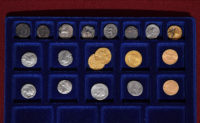 The search is on for the legal owner of an exceptional collection of coins found in a cellar in Hungary that was buried by someone who almost certainly died in the Holocaust. The coins were found in the town of Keszthely 120 miles southwest of Budapest this February when the current homeowners were digging a hole in a cellar. They dug out five glass jars, each filled with coins and carefully sealed. The jars held 2,800 gold and silver coins from all over the world ranging in date from antiquity to the 20th century.
The search is on for the legal owner of an exceptional collection of coins found in a cellar in Hungary that was buried by someone who almost certainly died in the Holocaust. The coins were found in the town of Keszthely 120 miles southwest of Budapest this February when the current homeowners were digging a hole in a cellar. They dug out five glass jars, each filled with coins and carefully sealed. The jars held 2,800 gold and silver coins from all over the world ranging in date from antiquity to the 20th century.
Almost half of the coins are from Pannonia, which was a province of the Roman Empire that covers modern-day western Hungary, according to Ferenc Redo, an archaeologist and coin expert.
The others are mostly antique coins from around the world, including pre- and post-revolutionary France, 19th century German territories, and both Tsarist- and Soviet-era Russia.
Many are from even farther afield, including South America, Africa, Asia and British-ruled India.
The house where the collection was found was in the ghetto in 1944 and given the presence of early 20th century coins, it’s almost certain they were buried by their Jewish owners in the desperate hope they might return to reclaim them at the end of the war.
 The homeowners turned the coins in and they are now in the custody of Keszthely’s Balatoni Museum. There was also some jewelry stashed with the coins, some engraved. The engraving provides a key clue to the possible identity of the collection’s owners: the Pollak family, successful traders who lived in Keszthely before World War II.
The homeowners turned the coins in and they are now in the custody of Keszthely’s Balatoni Museum. There was also some jewelry stashed with the coins, some engraved. The engraving provides a key clue to the possible identity of the collection’s owners: the Pollak family, successful traders who lived in Keszthely before World War II.
The Holocaust struck like a whirlwind in Hungary. Even though Hungary had passed draconian anti-Jewish laws for decades (it was the first European country to do so after World War I), the government resisted Nazi pressure to expel/deport/murder its Jewish citizens on the grounds that the “Jewish problem” would be better solved by slaughtering them after the war was over, because their labour and skills were needed during the war.
That’s how Hungarian Jews managed to survive most of the war without being destroyed. Ghettoized, entrained, marked and immiserated, most assuredly, but still alive. As late of the spring of 1944, there were 800,000 Jews in Hungary, one of the largest extant Jewish communities in Europe at that time.
That changed in March 1944, when German forces occupied Hungary. The tides of war had turned against Germany and the Hungarian government was actively making peace overtures to the Allies. Hitler wasn’t having that, so the relatively hands-off alliance ended and occupation began.
Adolf Eichmann came in and did his monstrous thing. With the sickening efficiency that had become his trademark, he divided the country into six zones and emptied each in turn of its Jews. Deportations began on May 15th. Between then and July 8th, 440,000 Jews were sent to concentration camps, mostly Auschwitz. Three thousand people a day, every day for six weeks, arrived on cattle cars at Auschwitz, 90% of them killed on arrival. The influx was so great that the crematoria could not keep up.
According to the 1941 Hungarian census, there were 755 Jews in Keszthely, about 6% of the town’s total population. On May 15th, 1944, 768 Jews from 319 families were locked into the ghetto, a few blocks centered around the town’s handsome 19th century neoclassical synagogue. On June 20th, 719 of the Jews (the rest used for slave labour) were moved to the Zalaegerszeg ghetto, then to Auschwitz. Twenty-two members of the Pollak family, five of them children, were among them. By the time the deportations ended in July, 829 Jews had been deported from Keszthely. When the war was over, only 64 of them had survived. Today just a dozen Jews live in Keszthely.
The museum plans to digitalise the collection and enlist archivists and historians to scour the Pollak family tree in search of descendants.
If no owner can be found, the collection will revert to ownership by the state.
“We also hope the exhibition will spread the word about the coins, and that a legal owner will turn up,” Havasi said.
I, and several others, object to ownership reverting to the state. We believe the ONLY honorable action would be to donate the collection to Yad Vashem. 😥
Maybe yes, but what has been minted in Pannonia should probably stay in Pannonia, as it is almost certain that the ancient coins were buried by several owners in hope they might return at the end of the fights, on –by now– altogether several(!) occasions.
Moreover, if half of the 2,800 gold and silver coins are from Pannonia, we are seemingly talking about a complete Pannonian silver and gold hoard of 1400 coins on its own, which is nothing what a serious and honest ‘collector’ usually finds via some kind of ‘freak accident’, or is it?
:hattip:
————–
PS: If I may ask, Who would be the ‘several others’?
@Emily –
Assuming arguendo that it would be appropriate to donate the coins to Yad Vashen, there still needs to be an owner to do the donating.